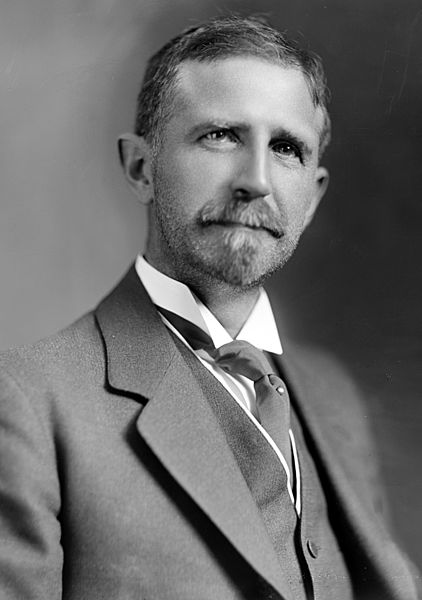
Charles Mitchell could save the stock market, but even he wasn’t rich enough to save all of the other areas of the U.S. economy that were suddenly struggling in 1929. A slowdown in steel manufacturing created a domino effect in the U.S. economy in general. A domino effect is when a change in one area creates a series of changes in other areas. In the image on the right, you can see that pushing over the domino on the left results in the other dominoes falling from left to right. The last domino on the right hasn't fallen yet, but it's just a matter of time before it does.
Watch this video to learn more about how a slowdown in American manufacturing affected the whole economy and circled back to threaten the stock market.
![]() By 1929, key areas of manufacturing were slowing down. Steel production in mills like this one
was declining, and that triggered a “domino effect” through the rest of the U.S. economy. Less
steel being produced meant there was less construction. Buildings are built with steel beams.
Less steel means less building. Less building means fewer jobs, as construction companies lay
people off because there is less work for them to do. Other industries also begin to lay people off.
More layoffs means rising unemployment, which means people are not earning money to buy
things. Lower consumer spending means companies make less money on sales, and more people
are laid off. People who are unemployed also have no money to buy stocks, or to pay off what
they owe to the banks or to their stock brokers. In this situation, the stock market should begin to
fall, as fewer stocks are purchased. But in 1929, the opposite happened: it just kept rising, due to
speculation. People desperate to make money bought more stocks on margin, hoping one would
get hot and pay off their debts and make up for losing their jobs. Stock market growth was not
based on real values, or real money. It was based on speculation, and it was headed for a fall.
By 1929, key areas of manufacturing were slowing down. Steel production in mills like this one
was declining, and that triggered a “domino effect” through the rest of the U.S. economy. Less
steel being produced meant there was less construction. Buildings are built with steel beams.
Less steel means less building. Less building means fewer jobs, as construction companies lay
people off because there is less work for them to do. Other industries also begin to lay people off.
More layoffs means rising unemployment, which means people are not earning money to buy
things. Lower consumer spending means companies make less money on sales, and more people
are laid off. People who are unemployed also have no money to buy stocks, or to pay off what
they owe to the banks or to their stock brokers. In this situation, the stock market should begin to
fall, as fewer stocks are purchased. But in 1929, the opposite happened: it just kept rising, due to
speculation. People desperate to make money bought more stocks on margin, hoping one would
get hot and pay off their debts and make up for losing their jobs. Stock market growth was not
based on real values, or real money. It was based on speculation, and it was headed for a fall.
The fact that the stock market was more than ever based on the reckless speculation of Americans in debt rather than on strong manufacturing and a strong economy overall should have made more people suspicious of the stock market's real value. Americans should have started to turn away from the stock market. But very few did, and anyone who criticized the stock market was rejected.

In September 1929, an economist named Roger Babson, shown here, gave a speech at the Annual National Business Conference at Babson College (yes, he founded it). In that speech Babson let everyone know just how much he did not like the stock market. He said that “sooner or later, a crash is coming, and it may be terrific.” (Terrific can mean "huge.") Babson’s prediction spooked the market and caused a small drop in stock values. But Wall Street quickly recovered as Americans decided Babson was crazy not to “like” the stock market. Just seven weeks later, they found out just how sane he was.
Question
Why didn't Americans want to listen to Babson?
